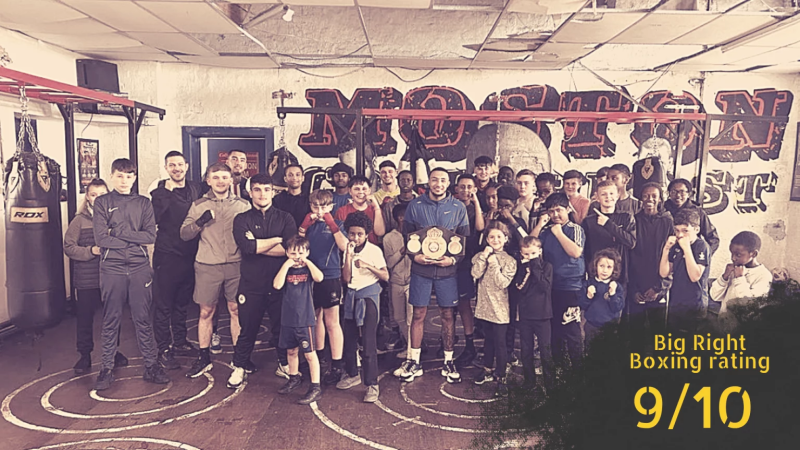
- Summary: A humble but mighty, old school community gym
- Address: Lightbowne Rd, Manchester M40 9EG
- Google rating: 4.4
- Opening hours: M, W, F: 4:30-6:30pm
- Pricing: £3 per class
- Online: website, Instagram, Facebook
For over 100 years (yes, ONE HUNDRED!), Collyhurst and Moston ABC has been training local champs and helping people of all ages find their passion for boxing.
There’s nothing fancy about this place. There are holes in the ceiling and it hasn’t seen any paint in years. But that’s exactly how boxing gyms should be: simple, full of dedication and free of ego. Its worn down facade tells its long, proud story.
They offer classes for people of all ages and abilities every Monday, Wednesday, and Friday evening, and at just £3 a class it’s incredible value. They have trained plenty of local champs here so you know you’ll be getting genuine boxing coaching, none of this boxercise stuff.
As well as being a great place to train, Collyhurst & Moston is also a big part of the local community. It offers classes to the most vulnerable local youths and even has a mobile gym that they take around the city to help more people get exposure to the sport.
A great gym with a rich history. Well worth a visit.
courtesy of Big Right Boxing
related pages Brian Hughes
Made In Manchester
THERE’S a fairytale quality to the boxing trope of the kid from humble beginnings who hits the big-time after learning his craft in a rundown, dingy gym, seemingly more fit for demolition than for developing champions. But that story has played out time and again throughout history. One of the best examples domestically dates from 1927, and the birth of a ramshackle makeshift gym in the Collyhurst district of Manchester. It would produce not one but three outstanding champions.
The place got going when the local St Malachy’s men’s football club disbanded, vacating its clubroom above a coalyard in Paley Street. Local boxing man Harry Fleming was running an amateur club in St Norbert’s Hall in Varley Street at the time. He decided to take over the St Malachy’s clubroom and turn it into a gym. His first members were lads he knew from St Norbert’s Hall. They included the Keogh brothers, Boy Tomlinson, Tommy Armstrong, Jack Curran, Jack Bates and Jackie Brown.
The gym was spartan to say the least. Its walls were bare brick and whitewashed, and its floorboards were thin and springy, with quarter-inch gaps running the length of the room, through which seeped fumes from the naphtha-lit coalyard below. The furnishings were just as basic: a bare iron fire-grate, a cold water tap, a rickety and narrow six-foot trestle that served as a rubbing table, a couple of heavy bags filled with sand and a speed ball. The fighters trained in worn-out 8oz horsehair gloves, and their skipping ropes and the rope used to section off an area for sparring were made by Curran’s father, a former sailor.
Nevertheless, Fleming soon had a stable of promising young pros. His fighters earned their spurs in weekly shows staged in small towns such as Ashton, Oldham, Northwhich and Congleton, as well as at the better-known Morecambe Winter Gardens and the Adelphi in Salford. From 1930, fight fans could see the stable in action at the local public hall at Churnet Street and the nearby Harpurhey Baths.
When possible, Fleming would ask promoters to book at least three of his boys for a single show, creating a sense of cohesion and camaraderie as they travelled together to engagements. If there were no fights on, Harry would send his more promising lads on a few weeks’ tour with Bert Hughes’ boxing booth to gain valuable experience.
Jack Bates and Henry Fitzsimmons (aka Young Fitz) were the first of Fleming’s boxers to make their presence felt in the northern rings, and after retiring from the ring, Bates became the gym’s resident trainer and a vital ingredient in its success.
Charlie Barlow, Ted McGuire, Dick Manning, Frank Fletcher, Bob Hesford, Arthur “Boy” Tomlinson, Jack Sloan, Alf Misell and Alf Robinson were among the well-known Collyhurst men of the gym’s early days. But the two standout talents were Jackie Brown and Johnny King, soon joined by a third in Jock McAvoy.
The Collyhurst gym had some keen inter-city rivals in a couple of stables from nearby Salford, which were particularly strong in the fly and bantamweight divisions. This provided some hard ‘learning’ fights for Brown and King as they rose up the ranks.
Brown became British, European and world flyweight champion. King was crowned British bantamweight titlist, and made a valiant bid for world glory when he lost on points to the great Panama Al Brown. And McAvoy would go down as arguably Britain’s greatest ever middleweight. He owned the British belt for most of the 1930s but, as with King, world honours eluded him, not least after he flattened the reigning world middleweight champion, Eddie “Babe” Risko, in a round in a non-title fight. Although only Brown picked up a world crown, these three men were all world class. But had it not been for Fleming and his ramshackle gym, the boxing world may never have seen their talents.
by Alex Daley